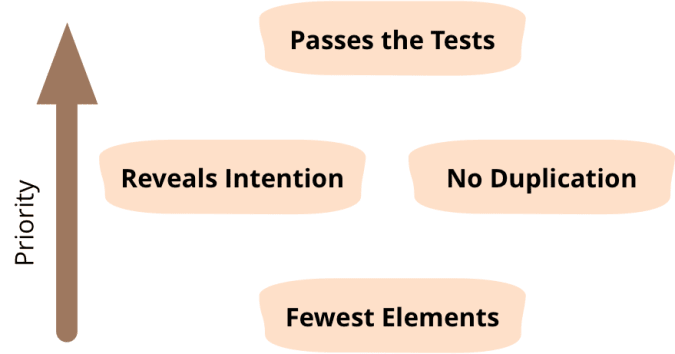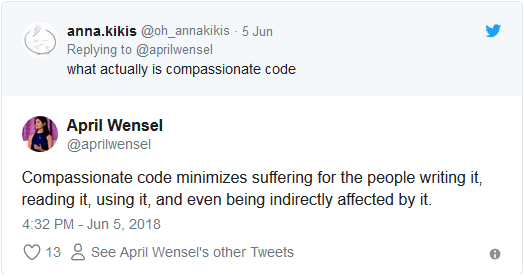Software design and software architecture are topics which are sometimes associated with distant, slightly mad geniuses, living in an ivory tower and regularly throwing UML diagrams to their ground crew of “normal” developers. They are seen as arcane knowledge which can only be absorbed by the most experienced, most talented “10x developers“, “rockstars” and “ninjas”.
From my experience, this point of view couldn’t be farther from reality. On the contrary I see software design and architecture as fundamental parts of any kind of development work. The moment we start writing code, we will make decisions and are creating software design, no matter if we are aware or not.
Of course there might be guidelines, there might be an architecture given by others, there might even be detailed API descriptions and an abstract design which paints the big picture, but in the end the little, daily decisions will have a huge impact on the result.
Understanding the rules of good software design is therefore a topic which affects developers of any skill and experience level.
Knowledge in that field will be extremely beneficial for every task related to software development.
Four Rules of Simple Design
Kent Beck, developer of Extreme Programming (XP) and Test-Driven Development (TDD), came up with four rules of simple software design in the late 1990s, which Martin Fowler expresses like this:
Martin gives a great, comprehensible description in his article about the “BeckDesignRules” which is also the source of the picture above.
I will try to take a deep dive into these rules, their spirit and how they can be practically done in database development. There is also much personal interpretation from my side and I’m not entirely sure whether Kent Beck would agree on all of my thoughts (of course I hope so).
I will split this up into several blog posts (you wouldn’t believe how hard it is anyway to keep my personal goal of one post per month) and today’s post will cover the first, probably most important and impactful of Beck’s design rules:
Passes the Tests
This one is clearly about Unit-Testing, Test-Driven Development and lots of green lights in your testing report, isn’t it? It means that good software design must adopt specific patterns from XP or other agile methodologies, right?
While I can’t tell what Kent Beck had in mind exactly when he came up with these rules, I think this interpretation is way too short-sighted and narrow. Because if we talk about passing the tests we first have to think about the tests:
What are the tests the software has to pass? What are the requirements? What should my software, my function, my code do?
And suddenly we left the layer of dogmatic, technical discussions about frameworks and methods and entered the field of “business knowledge” or “domain knowledge”. This is the layer which has to be the source for our definition of “tests”. This is the layer which will provide the most value.
Our software, after all, exists to solve a specific problem which will most likely be a business problem. Without knowledge about the problem and its environment, our chances to solve the problem are limited at best, no matter which agile method we use, which database managagement system or which language.
It’s one of our most important tasks as developers to close these understanding gaps, to get knowledge about the problem’s domain.
Therefore our duties are not only to learn about algorithms, normal forms and indexing strategies but also to learn about our customers, to ask questions and to adopt the viewpoint of people who will end up using our software.
And that’s not even enough: as database developers this also means that we not only need to understand our data model but also need decent knowledge about how the application that will use our database works.
If we design a model or create a functionality the application is not able to use, it’s not “that stupid app developer’s fault” but a lack of domain knowledge on our side.
It’s also a mistake of our whole team.
Even if we consider the functionality or model to be a good solution to the underlying problem and the change should be done in the application instead we have a responsibility to communicate our point of view in an empathetic and understandable way.
Definition of tests
If we know enough about the problem, we can start to define the tests our software needs to pass. This definition can be similar to the definition of done in agile methodologies, a formal contract specification or functional requirement we agreed upon with our customer (although that will not be detailed enough in most day-to-day problems) or just a picture in our head, depending on the circumstances.
The more complex a problem or functionality is, the more beneficial it is to have the defintion and tests written down in some way.
They can be written as unit-tests, as formal design-by-contract specifications but also as list of requirements on a wiki-page.
Writing down things can also help to increase your domain knowledge.
Especially when dealing with legacy code I found it extremely helpful to analyse existing code line-by-line and write it down in a non-code way. After that I can often identify logical problems and extract definitions for tests more easily, particularly if the legacy code to deal with is very verbose and “grown”.
Of course there are benefits you get with some approaches over others but from my experience there is little to gain from forcefully chasing a specific method without taking the circumstances into account. Teams vary in experience, projects vary in maturity and quality, companies vary in available budget and established culture. We can take baby-steps if necessary. The most important part is to start walking.
Passes all the tests
There is no “some” in “Passes the tests”. Beck’s design rules contain a strong urge for quality and therefore our software or functionality has to pass all the tests. This not only includes the things it should do but also the things that should not happen.
Unwanted behaviour will always lead to user frustration (and therefore to loss of the most valuable currency a company has: trust). But especially in the context of database development unwanted or unexpected behaviour can lead to serious implications like data loss or corrupt data – things which are very hard to repair afterwards.
“Passes the tests” comes with a zero-tolerance approach to erroneous behaviour and therefore raises the question about the things that can go wrong. What if we get a negative number? What if a certain column is NULL? What if the select returns no rows? What if it returns more than one?
We might have defined the “happy-path” of our software, but dealing with the consequences of unwanted input or state is equally important.
Limiting the scope
We are suddenly in a situation where a once simple requirement became an enormous monster of edge-cases, possibilities and required tests. We are facing a lot of uncertainties and after thinking about all the tests that need to be covered we are maybe even tempted to throw away all that crap about good design and just “get the job done”.
While this might be a pragmatic and reasonable approach for some situations, in most cases it will be a trade for quick success now and tremendous maintenance costs in the future.
However, there are some possibilities to deal with the suddenly increased effort needed, and one of them is limiting the scope.
A designer knows he has achieved perfection not when there is nothing left to add, but when there is nothing left to take away.
— Antoine de Saint-Exupery
Define what your software should do and narrow it down.
If your software manages the vacation of members of the imperial army, it doesn’t necessarily need to be able to manage the (probably totally different) vacation rules of the rebels – if there are any.
It definitely doesn’t need to know about the history of sith (even if some national holidays are named after the most powerful sith). And if it’s not likely that we are about to sell our software to both, the imperium and the rebels, we should not start with thousands of abstractions and configuration options to support the specific vacation rules of every party in that galaxy far, far away.
Some features are not debatable beause they are strongly requested by the customer or essential to solve the existing problem. But some (especially the ones which include high uncertainties) can probably be delayed until we have grown a better understanding of the problem domain, which will then lead to better decision making. Others might fall into the category of YAGNI (You aren’t gonna need it) and can be skipped completely.
Be eager to drop complexity! If there is no compelling need to do it in the more complex, more generic way, don’t do it. You can always increase complexity later if you have increased your knowledge and mastered the basic challenges. But you will have a hard time going with the full-blown approach from day one. And there is a high chance you will end up with software including a bunch of non-tested features and a bunch of others that nobody needs – especially if the former don’t work correctly.
The power of databases
There is another possibility to deal with the efforts needed: Limit the uncertainties.
We database developers have immensely powerful tools to do so: the relational model and constraints. Both can be natural scope-limiters built right into our database. You expect a certain column to have a specific range? Assure it by creating a constraint. You expect a vacation-day spent to belong to exaclty one imperial soldier? Use different tables and the foreign key constraint to set this rule into stone.
I mentioned contract-by-design previously. The functionality to use it (at least to some extent) is built into every mature RDBMS.
Some constraints (especially ones involving different tables) are more complicated to create, but the tools are available. Whenever you have the possibility to eliminate uncertainties, do it! It limits the complexity and things that can go wrong and need to be handled.
I once analyzed a database which contained no constraints besides primary keys and when I asked the developers why, they told me they’d assure everything via “hibernate constraints” inside the middleware.
It didn’t took long until the tables were cluttered with corrupt data and the effort to handle those uncertainties when consuming the data enormous.
A simple example
Let me show a very simple example how we can use a combination of the relational model and constraints to limit uncertainties.
We want to create a name generator for sith and need a table which stores the possible titles a sith can get. We also want to have the possibility to define a specific title as being the default title.
create table sith_title (
id int identity(1,1) primary key,
title nvarchar(100),
is_default bit default 0
);
insert into sith_title ( title, is_default ) values ( 'Acolyte', 0);
insert into sith_title ( title, is_default ) values ( 'Sith', 1 );
insert into sith_title ( title, is_default ) values ( 'Sith Lord', 0 );
insert into sith_title ( title, is_default ) values ( 'Darth', 1 );
select title from sith_title where is_default = 1;
As we can’t be sure that we will get back only one default entry we will have to handle the possibility of multiple default values in every functionality which needs that default title information.
There are several solutions to limit the uncertainty in this case, including triggers, but a very simple one just uses the relational model and a unique constraint:
create table sith_title (
id int identity(1,1) primary key,
title nvarchar(100)
);
create table sith_title_default (
id decimal(1,0) not null primary key default 1,
fk_sith_title integer not null,
constraint fk_sith_title foreign key ( fk_sith_title ) references sith_title ( id ),
constraint chk_id check ( id = 1 )
);
insert into sith_title ( title ) values ( 'Acolyte');
insert into sith_title ( title ) values ( 'Sith' );
insert into sith_title ( title ) values ( 'Sith Lord' );
insert into sith_title ( title ) values ( 'Darth' );
insert into sith_title_default ( fk_sith_title )
select id from sith_title where title = 'Darth';
select title from sith_title where id = (select fk_sith_title from sith_title_default);
insert into sith_title_default ( fk_sith_title )
select id from sith_title where title = 'Sith';
There is still the uncertainty of getting no default value, but we successfully eliminated the uncertainty of getting multiple default values and therefore can skip the handling of that in the consuming functions.
Automated self-testing
Of course “passes the tests” is also about the topic of automated self-testing (which includes unit-, integration-, regression- and all the other kinds of tests).
I wrote about this topic in detail and I’m convinced that including automated tests in your software will be very beneficial to your project in most situations.
But we have to keep in mind, that most automated self-testing (especially if it’s done only on a QA environment and not in production) is just a form of checking what we know.
It can not replace exploratory testing and solely relying on your unit-tests when shipping new functionality might be overconfident. If the software is used by people and is meant to solve problems of people, the “tests” should include them at some point.
More tests
What? Are we expected to cover even more tests?
I think there is a whole bunch of things we didn’t address yet but are worth considering when writing software.
This (non-exhaustive) list is not meant as a burden but as to widen our horizon:
- Security (SQL Injection, sensitive data, encryption)
- Performance (while there is the possible pitfall of over-tuning, decent performance ist a first class requirement)
- Usability (Is the functionality understandable? Is it easy to use? For whom?)
- Impact on multi-user situations (how will other users be affected, e.g. due to locks?)
- Privacy protection (do I really need to log this? When will it be deleted?)
- Scalability (How will this perform on 100 times the data?)
- Monitoring (How will I notice it doesn’t work as expected?)
- Safety (Will an error in this functionality harm people? How can it be avoided?)
- Concurrency (What happens if two users are using it at the same time?)
- What will happen if the database is going down mid-process?
Each of these things can turn into a necessary requirement and therefore a test our software has to pass.
That’s also the reason why I think that pure unit-testing and TDD is not a sufficient answer to Beck’s rules of simple design. It can be a part of it, but to identify which tests are necessary we need to develop a deep understanding of the problem domain, the people we want to help with our software and also our own environment, possibilities and circumstances.
A compassionate conclusion
Realizing that “passes the tests” might mean more than writing a happy-path unit-test for a function can be overwhelming and even demoralising. There are so many things to consider which sometimes even contradict each other. Maybe this whole thing is arcane knowledge, only available to the most experienced among our profession?
In my opinion Kent Beck’s design rules are a tool. To know them and consider them can be very beneficial in many situations. But they are not the only valid option and they are not a religion you should follow blindly.
Good software design depends. It depends on the problem, it depends on the available resources, on the people who are involved, on the scope and the goal of the project.
And it also depends on the experience of the developer. On the culture of the company. On the quality of the software that already exists.
I like this quote very much, because it is pragmatic without the whole arcane, elitist attitude we see so often in the tech industry.
“Passes the tests” can lead to more successful projects, it can help in writing better software and creating better software design.
It can help to reduce suffering of the people involved, be it users, developers, testers or the support team. But if it turns into dogma and starts to cause suffering instead of reducing it, there’s something wrong which should be investigated. And maybe it’s not the right tool for the job.
Great software design, first of all, embraces compassionate code.
I will happily take baby steps towards that.










Latest comments (4)
For those worrying about the potential explosion of tests in trying to cover lots (effectively infinite) of edge cases and bad inputs, there is some hope from at least a couple of sources:
James O Coplien's seminal paper: rbcs-us.com/documents/Why-Most-Uni... which takes a slightly acerbic but very practical and well thought out view of where and how to test.
The insight of your fellow dev.to member, dev.to/roesslerj/ and others in the testing community, who understand this in excruciating detail and want to help :)
I wonder - did my article really leave that feeling, being worried about the amount of unit tests needed?
If so, I did a terrible job and apologize.
My intention was to point out that automated unit tests are not the solution (though they might be one of several tools), but deeper understanding of the problem domain (I think in that case I follow Jim Copliens argumentation pretty much).
Also, please consider reading the article on automated self-testing I wrote and linked in the post (also on dev.to: dev.to/pesse/strongholds-of-confid...)
Cheers,
A very concerned Pesse
My apologies too, I wasn't reacting so much to your excellent article, as wanting to provide more information on the meaning of valuable tests, I guess I used the wrong phrase to introduce them :)
Thanks for your reply. As newbie-writer feedback is very important for me and I was really concerned.
Also thanks for the recommendation of roesslerj - didn't know his work yet.